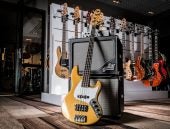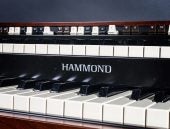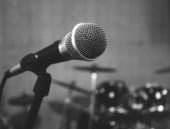The Fretless Bass: The Pros & Cons
Published on Thursday 19 August 2021
The fretless bass is actually pretty rare in the bass world, since most bassists simply prefer fretted models. Listen to the bass of any current hits and you’re likely to be listening to a fretted bass. But there’s no doubt that the fretless bass packs unique character and there are plenty of devotees out there that refuse to play anything else. So, what’s the deal with the fretless bass – what are the good bits? And what are the not-so-good bits?
 Foto’s: Gerard Burgers
Foto’s: Gerard Burgers
- Unique Character
- All of the Music
- Playing in Tune
- Precision Bass
- Jaco Pastorius
- That Fretless Lilt
- Playing Fretless Bass
- Things Worth Knowing
- With or Without ‘Stripes’
- Choosing Strings
- What About Fretless Guitars?
- See Also…
Unique Character
“It takes a trained ear to notice if a track is played with a fretted or fretless bass. Especially since the bass is often buried under the other instruments. But at the same time, if a track is played with a fretless bass, it’s usually going to have a pretty prominent role. Which makes sense, since the fretless bass has an entirely unique character.” At least that’s the view of Hans Naves, who has been playing fretless for forty years already, meaning that he’s had more enough time to form a pretty reliable opinion on the matter. But, if you have a quick scan of his studio, you’ll notice that he also has a few fretted basses in his collection, as well as a six-string. “Ok, so my preference will always be a fretless bass, but I’ll pick up a fretted bass every now and then. Sometimes it’s necessary, especially if you’re playing on a track that demands slap bass. Of course, you can play slap bass with a fretless model but it doesn’t quite sound right. The classic ‘slap’ sound is created by the strings clattering against the frets, and since a fretless bass doesn’t have any, the strings are just slapping against the wood of the fretboard. It’s an entirely different sound since the tone is just killed off.”
All of the Music
According to Hans, slap bass is actually the only thing you can’t play on a fretless bass. “Besides that, you can play everything. Even rock and heavy metal where everything needs to be straight forward. I’ve actually played with a heavy metal band using a fretless bass. It can happen. I also think it adds an extra dimension. But, of course, it’s not all that common.” Hans gives us a short demo of what the fretless bass can do and it becomes pretty clear, pretty quickly, that there’s a lot you can do with a fretless bass that just isn’t possible with a fretted bass. Stunning vibratos; smooth glides from one note to another; the ability to give each note its own colour. It’s actually awesome. So awesome in fact that it leaves you wondering why most bassists are so married to their fretted models. Hans has no explanation for this either. Pure convenience maybe? A fretless bass is harder to play, right? “I honestly have no idea. All I can tell you is that I’ll probably die with a fretless bass in my hands. You can apply far more colour with a fretless bass. I mean, these days I make music where you can always make the most of that, like Jazz, but you can do a lot of great things when playing pop music with a fretless bass. When I’m playing fretless, I feel like I have a deeper connection with the act of making music. I can immediately add my own expression and that’s just endlessly inspiring.”
Playing in Tune
In any case, you’re not necessarily making life easier for yourself by playing fretless bass as well as fretted bass. The biggest challenge when playing fretless is actually playing in tune. In other words, knowing whether or not you’re hitting the right spot on the fretboard and actually playing the right note. You have to be able to play with millimetre-precision, just as you do with a double bass, which is a fretless bass by definition. “A fretted bass gives you a little breathing room. Even if you don’t hold the string in precisely the right spot, the fret will make sure that the note is on point, but a fretless bass doesn’t offer that freedom. You need to place your fingers in exactly the right spot, especially in the higher ranges where the notes get closer together. At the same time it can actually be nice when the note almost touches the right spot or even floats around it. It’s all part of the character,” says Hans. But if you’re planning to play fretless bass as well as fretted bass, just make sure to schedule in an extra hour or so of practise time. “Yeah, maybe a few hours,” admits Hans, “It can take some time to figure out what the fretless bass can do and how to do it. I can’t help but notice that, if I’ve been practising a lot of fretless bass, my fretted bass playing also improves. Playing fretless demands greater precision, which will only benefit your fretted bass playing in the long run.”
Precision Bass
From an historical perspective, the fretted bass actually came before the fretless bass. While the original sound of a bass was born out of the fretless sound of a double bass during the boom of Big Band bands, the dawn of the electric guitar forced bands to get louder, so much louder that the double bass was almost completely drowned out, forcing double bassists to stand up and strike the strings with immense force. It was hard work. It was seeing this that inspired American guitar builder Leo Fender to develop the bass guitar as we know it today. He simply based his design on the normal electric guitar – removing the large hollow body of the double bass and replacing it with a solid body loaded with a pickup that registered the vibration of the strings before sending an electric signal to an amplifier. The biggest plus: the electric bass is smaller and lighter than the traditional double bass and therefore much more manageable. But it’s here that Leo Fender took things a step further by adding frets to the fretboard of his bass, making it much easier to produce pure and precise notes, which is exactly why he named his revolutionary instrument the Precision bass. As we’re now fully aware, the Precision bass that first appeared in 1951 was an immediate success and is still the most played and most recognisable bass on the planet.

Jaco Pastorius
Jaco Pastorius
“Somewhere in the sixties, a fretless version of the Precision bass came out,” remembers Hans. “But it stayed far in the background. Fretless bass only really got interesting in the seventies when Jaco Pastorius ripped the frets out of his Jazz bass. The Jazz bass has a slimmer neck than the Precision and different pickups – and more of them – which gives the Jazz a more overtone-rich sound of its own – a sound that really works with fretless bass. The perfect match.” Soon, other bassists started to explore the fretless world, including the likes of Gary Willis, Percy Jones and John Giblin. “Yeah, those guys were really inspiring for me,” says Hans. “I just wanted to do all of the things that they could. That’s definitely where my love of fretless bass started. Jack Bruce from Cream was also a big name for me. And don’t forget Sting. He played fretless bass in The Police and did it really well. Just have a listen to ‘Every Little Thing She Does is Magic.”
That Fretless Lilt
The love for the fretless bass that was first inspired in Hans back in the seventies has never gone away. “I just remember thinking, ‘that’s how a bass should sound!’. I still think that. The incredible richness of tone and all of the different ways you can play a single note. I basically see the fretted bass as digital and the fretless bass as analogue.” Besides that, the fretless bass definitely presents more musical potential and more creative range. The tone is also substantially different from that of a fretted bass, which is a technical thing. With a fretted bass, the string makes contact with the metal fret, so it’s essentially pulled tight across a sharp edge, which you hear in the resulting sound. With a fretless bass, it’s completely different. Your finger simply pins the string to the wood of the fretboard. There are no sharp metal edges, so the wood naturally resonates in response to the vibrating string, and a specific timbre is added to that resonance depending on the kind of wood used to make the fretboard. It’s these factors alone that make a fretless bass sound remarkably different from a fretted bass. “You can also do a lot more with your fingers,” says Hans, and he shows us exactly what he means. “You can perform a vibrato, glide from note to note, and colour in each note you play – just with your fingertips. That’s the secret to the lilting sound of a fretless bass. That’s what gives it life. That’s also why you could say that the instrument comes close to the human voice.”

Playing Fretless Bass
Say you’re a bassist that’s ready to start playing fretless bass. The first thing you’ll probably need to do is find a fretless bass that you like. “That’s probably going to be a bass that, in terms of features, comes close to the fretted model that you already know you prefer,” advises Hans. “And from there, it’s all about the neck. If the neck feels right – whether the bass is fretless or fretted, in fact – then the bass is right. Try fretboards made of different woods. My personal preference is ebony, since it’s more dense and hard, which makes each note clearer. Once you’ve found the right bass, it’s simply a question of exploring and making playing the fretless bass all your own. And that takes a lot of time and a lot of practice. I actually recommend using the kind of playing posture that you would use to play classical guitar,” (see photo above), “and keep the wrist of your right hand straight. You’re going to be playing for a few hours, so you might as well be comfortable. It also help to keep the neck close so you can play comfortably with the tips of your fingers. With a fretless bass this is important because the notes are literally held by your fingers.” Hans finishes with another golden nugget of advice: “Don’t be tempted to pluck the strings too hard. Keep your playing subtle to give the played note more richness of sound. I also have a more subtle approach to playing the fretted bass, but with a fretless bass, the need is far greater.”
Things Worth Knowing
With Or Without ‘Stripes’
You can split fretless basses into one of two groups: basses with ‘stripes’ (or fret markers), and basses without. These stripes are position markers inlaid where the frets would usually be and combine with standard dot position markers to help note navigation. Apart from that, it’s exactly the same as a fretless bass without any markers. However, a bass with no position markers at all can be a little disorientating. You’re essentially forced to play based on what you hear and feel, just as you would with a double bass.

Choosing Strings
Most fretless basses will come pre-loaded with a set of roundwound strings which have incredible sustain and produce more overtones, but you’ll also sometimes see flatwound or tape-wound strings. While the kind of strings you choose is usually a question of the tone and colour of sound that you prefer, the wood of your fretboard can also play a big role, since roundwound strings can cause damage. However, Hans personally insists that roundwound strings are still the best: “The sound is just far richer. And a worn fretboard can always be sanded back to health with a little steel wool.”
What About Fretless Guitars?
If the fretless bass exists, then it’s only logical that the fretless guitar also exists, right? And they do, but they are far more rare than fretless basses. If you’re curious, watch the clip of ‘Erotic Cakes’ by The Aristocrats included below to see guitarist Guthrie Govan playing a fretless guitar.
See Also…
» Fretless Basses
» All Bass Guitars & Accessories
» Top 10 Songs With A Smashing Bass Intro
» How do I become a bassist?
» What is the best bass guitar for me?







played on a Washburn fretless bass. played on frets for so long. fingers are in alignment from memory. best sounds I ever heard were from fretless.
I play a 70 fretless p bass. I play other basses as well, but my favorite playing & sounding bass by far is my frettless
More freedom on fretless lead bass,amagination,to the limit.”Peace”.
”According to Hans, slap bass is actually the only thing you can’t play on a fretless bass.”
Les Claypool: “Hold my beer…”